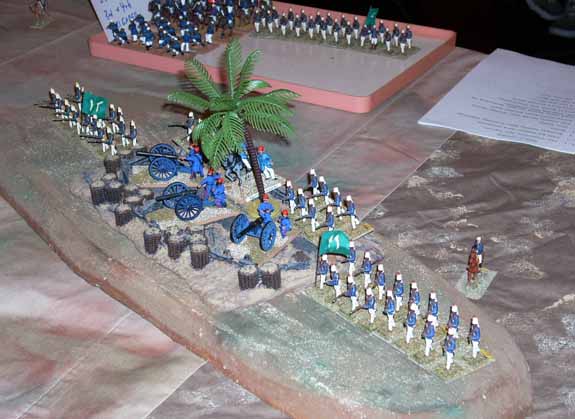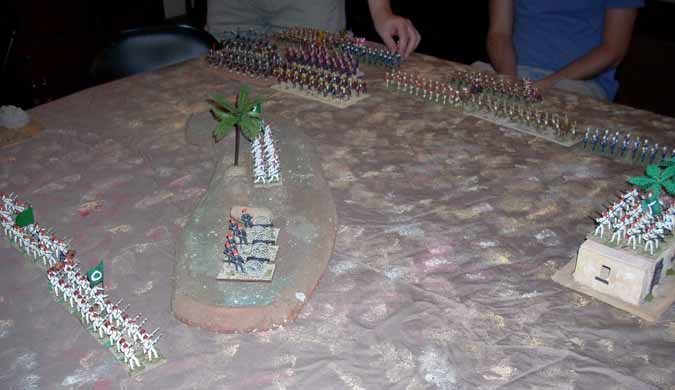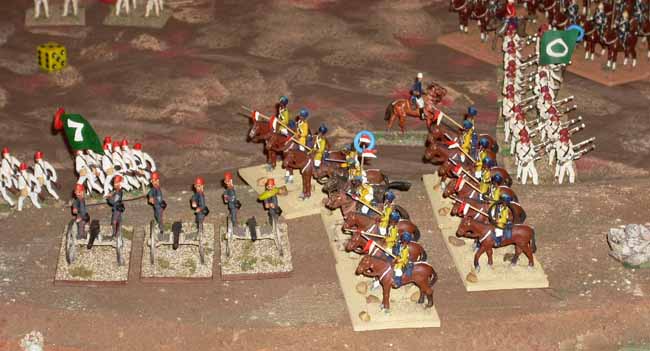

The 1882 Anglo-Egyptian war
Decision in the Desert
Page 2

Photo by Ed Sansing
"Pasha" Jim Pitts' position in the center of the Egyptian line. This is during the game's set up. The redoubt in the center of the hill was important to the Egyptian victory conditions, but the Anglo-Indian forces did not know that.

Photo by Ed Sansing
The Egyptian right, troops commanded by "Pasha" Clay James. Unfortunately, this division of two brigades (each of three regiments) was attacked frontally by British infantry, and from the flank by the Anglo-Indian cavalry.
Who were the players in this Game?
The Egyptians were led by "Pashas" Jim Pitts, Ed Sansing, Bill Hamilton and Clay James.
The British/Indian forces were commanded by Sean Pitts, Elliot Haller John Murdaugh and Phil Young.

Photo by Ed Sansing
The British appear. Their whole force concentrated on 1/2 of the battlefield. Their massed cavalry is poised to strike against Pasha Clay's infantry on the Egyptian left.

Photo by Ed Sansing
The view from the Egyptian side. The house or village on the extreme right of the image (note Egyptian infantry defending on roof) was another location that had to be held by the Egyptians as part of their victory conditions.
Photo by John Murdaugh
The same house after it was seized by the Royal Marine light infantry under the command of General Murdaugh. The Naval landing party (Sailors with rifles) to the right of the house look to have been roughly handled, with only 3 companies remaining out of 5 at the beganning of the battle.

Photo by Ed Sansing
The first of many cavalry charges that held and wore down the Egyptian left. Pasha Clay has moved his other brigade forward to block the flank.

Photo by Ed Sansing
The "thin line" of Egyptian infantry face the British lancers. This is the first of the British cavalry charges by General Haller.

Photo by Ed Sansing
On the hill the Indian lancers (Skinner's Horse) have forced the infantry to retreat and used their bonus move to close with the artillery battery.
What were the objectives in this game?
Both sides were attempting to reduce the enemy armies to less than 50% strength. The Egyptians had a central redoubt and two fortified villages. Each of these in Egyptian hands counted as a British unit "off the table" to determine victory conditions.
Photo by John Murdaugh
The British brigade salutes as the few remaining British Lancers trot by after their series of attacks against the "gyppies."

Photo by Ed Sansing
Not long after the previous view. The Egyptian artillery has retreated off of the hill. One Egyptian infantry regiment is gone, another is in square and yet another routing along the edge of the battlefield. In Larry Brom's rules, a unit will not "rout from the field" till it has a chance to rally, so this routed unit is "sliding" along the battlefield edge.
Photo by John Murdaugh
The Anglo-Indian cavalry attacks are over and the British infantry advances with the sole remaining British Cavalry (the Dragoon Guards) in reserve.

Photo by Ed Sansing
After a long LONG march from the Egyptian right flank Pasha Ed charges the Sepoy General Sean Pitts' infantry, but did not have enough movement to close. Pasha Jim causes enough casualties with supporting fire to finally cause a morale check on one of the Indian units.
That unit failed morale and caused the other two nearby units to rout along with it. A marvelous opportunity has opened up for the Egyptians to roll up the British-Indian left flank.

Photo by Ed Sansing
The Egyptian cavalry is facing three routed infantry only 14 inches away. As the Egyptian cavalry commander Pasha Ed Sansing recalls: "On my turn I rolled only 9 inches (with 5 die) and my brave troopers were unable to close with the routed enemy!"

Photo by Ed Sansing
General Sean Pitts is able to rally some of his units and the next British general John Murdaugh re-deployed some of his units to add to the fire brought to bear on the Egyptian Cavalry.
The Egyptian cavalry commander Pasha Ed Sansing continues: "While I was able to maneuver out of the artillery's field of fire I was engaged by four units of infantry and my troopers were very quickly reduced by the concentrated infantry fire."
Photo by John Murdaugh
As the Egyptian cavalry finally closes, the Indian units have reformed and fire will doom the cavalry charge.
So, Who won this battle?
The British were able to squeak out a hard-fought victory. The Egyptian army fell under 50% strenght at the end of turn six, while the Anglo-Indian force was still above 50%.
But the Egyptians had enough mounted troops to cover their withdrawal towards the Nile Valley. Another battle may be neccesary to decide the control of the Suez Canal.
The British concentration of all of their army against half of the Egyptian forces was decisive, along with the masterful cavalry attacks which devastated the two Egyptian left-flank Infantry brigades (half of the Egyptian army).
Go back to Part 1 of DECISION IN THE DESERT
Return to the Master Index of Photos and Games
Return to the Jackson Gamers' Homepage
Angelfire - Free Home Pages
Free Web Building Help
Angelfire HTML Library
htmlGEAR - free polls, guestbooks, and more!
Thank you for visiting The Jackson Gamers' pages at Angelfire. Please come back and visit again!